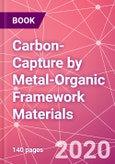Metal-Organic Framework Materials (MOFs) are well suited for absorbing carbon dioxide. MOFs can form highly-porous structures with great adsorption capacities. The book references 295 original resources and includes their direct web link for in-depth reading.
Metal-Organic Framework Materials (MOFs) are well suited for absorbing carbon dioxide. MOFs can form highly-porous structures with great adsorption capacities. They also offer good catalytic properties and much research refers to the relationship between catalytic performance and framework structure. In addition to simple CO2 absorption, there are other interesting applications, such as the direct electrochemical reduction into useful chemicals and fuels, the conversion of CO2 into methanol, the electrochemical reduction of CO2, or electrocatalytic hydrogen evolution (thus boosting the ‘hydrogen economy’). The book references 295 original resources and includes their direct web link for in-depth reading.
Table of Contents
Introduction
- Aluminium
- Barium
- Bismuth
- Cadmium
- Calcium
- Cerium
- Chromium
- Cobalt
- Copper
- Europium
- Hafnium
- Indium
- Iron
- Lead
- Lithium
- Magnesium
- Manganese
- Molybdenum
- Nickel
- Ruthenium
- Samarium
- Scandium
- Silver
- Terbium
- Titanium
- Zinc
- Zirconium
Miscellaneous
References
Keyword Index
About the Author
Author
Dr Fisher has wide knowledge and experience of the fields of engineering, metallurgy, and solid-state physics, beginning with work at Rolls-Royce Aero Engines on turbine-blade research, related to the Concord supersonic passenger-aircraft project, which led to a BSc degree (1971) from the University of Wales. This was followed by theoretical and experimental work on the directional solidification of eutectic alloys having the ultimate aim of developing composite turbine blades. This work led to a doctoral degree (1978) from the Swiss Federal Institute of Technology (Lausanne). He then acted for many years as an editor of various academic journals, in particular Defect and Diffusion Forum. In recent years he has specialised in writing monographs which introduce readers to the most rapidly developing ideas in the fields of engineering, metallurgy, and solid-state physics. His latest paper will appear shortly in International Materials Reviews, and he is co-author of the widely-cited student textbook, Fundamentals of Solidification.








